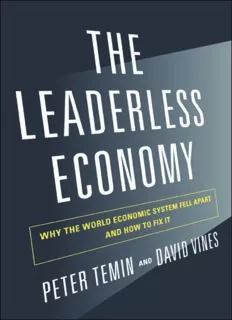
The Leaderless Economy: Why the World Economic System Fell Apart and How to Fix It PDF
Preview The Leaderless Economy: Why the World Economic System Fell Apart and How to Fix It
The Leaderless Economy The Leaderless Economy Why the World Economic System Fell Apart and How to Fix It PETER TEMIN and DAVID VINES PRINCETON UNIVERSITY PRESS Princeton and Oxford Copyright © 2013 by Princeton University Press Published by Princeton University Press, 41 William Street, Princeton, New Jersey 08540 In the United Kingdom: Princeton University Press, 6 Oxford Street, Woodstock, Oxfordshire OX20 1TW press.princeton.edu All Rights Reserved Library of Congress Cataloging-in-Publication Data Temin, Peter. Th e leaderless economy : why the world economic system fell apart and how to fi x it / Peter Temin and David Vines. pages cm Includes bibliographical references and index. ISBN 978-0-691-15743-6 (alk. paper) 1. Economic policy. 2. International economic relations. 3. Global Financial Crisis, 2008–2009—Government policy. I. Vines, David. II. Title. HD87.T416 2013 320.6–dc23 2012032589 British Library Cataloging-in-Publication Data is available Th is book has been composed in Minion Pro with ITC Franklin Gothic display by Princeton Editorial Associates Inc., Scottsdale, Arizona Printed on acid-free paper. ∞ Printed in the United States of America 10 9 8 7 6 5 4 3 2 1 For our children and grandchildren in the hope that they will soon see a return to prosperity For Peter: Elizabeth, Melanie, Colin, Zachary, and Elijah For David: Sam, Alexander, Louis, Luke, and Tom CONTENTS Preface ix ONE Th e World Economy Is Broken 1 TWO Th e British Century and the Great Depression 21 THREE Keynes from the Macmillan Committee to Bretton Woods 59 FOUR Th e American Century and the Global Financial Crisis 107 FIVE Restoring International Balance in Europe 151 SIX Restoring International Balance in the World 205 SEVEN Using Th eory to Learn from History 243 Appendix 257 Notes 275 References 283 Index 299 PREFACE The discussions that led to this book began aft er the eruption of the unpronounceable Icelandic volcano, Eyjafj allajökull, stranded Peter in London aft er a 2010 conference. David invited him to wait for the skies to clear in Oxford, leading to four days of discussion about the topics of this book. We transformed our clear agreement on the issues into a book outline during Peter’s week in Oxford in the spring of 2011, and we worked on it while David visited MIT in the fall of 2011 under the MIT-B alliol Program. (We fi rst met two decades earlier, when David hosted Peter at Balliol College under this same program, and have been in touch since.) We have been giving talks and writing papers on these themes over the past few years, and we decided that a full- length presentation of our thesis and its historical background would help current policy deliberations. We off er this volume to all who are interested in the world economy and distressed at the lack of understanding oft en shown in the popular press. As we describe in the text, we use only simple economic models and reserve discussion of the models— as opposed to the history and analysis— to an Appendix. For their feedback we thank the audiences at the American Academy of Arts and Sciences; the Asia Europe Economic Forum in Paris, Seoul, and Tokyo; the Australian National University; the Fundación Ramón Areces (Madrid); MIT; Oxford University; the Reserve Bank of Australia; Swarth- more College; the University of California at Berkeley; and Wake Forest Uni- versity. And we thank Christopher Adam, Christopher Allsopp, Ross Garnaut, and Max Watson for their insights along the way. We thank Balliol and Nuffi eld Colleges for accommodation while meeting in Oxford and Balliol College and MIT for accommodations while meeting in Cambridge, Massachusetts.
Description: